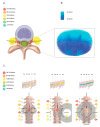Controversies and Clinical Applications of Non-Invasive Transspinal Magnetic Stimulation: A Critical Review and Exploratory Trial in Hereditary Spastic Paraplegia
- PMID: 36012986
- PMCID: PMC9409717
- DOI: 10.3390/jcm11164748
Controversies and Clinical Applications of Non-Invasive Transspinal Magnetic Stimulation: A Critical Review and Exploratory Trial in Hereditary Spastic Paraplegia
Abstract
Magnetic stimulation is a safe, non-invasive diagnostic tool and promising treatment strategy for neurological and psychiatric disorders. Although most studies address transcranial magnetic stimulation, transspinal magnetic stimulation (TsMS) has received recent attention since trials involving invasive spinal cord stimulation showed encouraging results for pain, spasticity, and Parkinson's disease. While the effects of TsMS on spinal roots is well understood, its mechanism of action on the spinal cord is still controversial. Despite unclear mechanisms of action, clinical benefits of TsMS have been reported, including improvements in scales of spasticity, hyperreflexia, and bladder and bowel symptoms, and even supraspinal gait disorders such as freezing and camptocormia. In the present study, a critical review on the application of TsMS in neurology was conducted, along with an exploratory trial involving TsMS in three patients with hereditary spastic paraplegia. The goal was to understand the mechanism of action of TsMS through H-reflex measurement at the unstimulated lumbosacral level. Although limited by studies with a small sample size and a low to moderate effect size, TsMS is safe and tolerable and presents consistent clinical and neurophysiological benefits that support its use in clinical practice.
Keywords: magnetic stimulation; neuromodulation; spinal cord.
Conflict of interest statement
The authors declare no conflict of interest.
Figures


Similar articles
-
Neurophysiological Changes After Paired Brain and Spinal Cord Stimulation Coupled With Locomotor Training in Human Spinal Cord Injury.Front Neurol. 2021 May 10;12:627975. doi: 10.3389/fneur.2021.627975. eCollection 2021. Front Neurol. 2021. PMID: 34040572 Free PMC article.
-
Electric Field Distribution during Non-Invasive Electric and Magnetic Stimulation of the Cervical Spinal Cord.Annu Int Conf IEEE Eng Med Biol Soc. 2019 Jul;2019:5898-5901. doi: 10.1109/EMBC.2019.8857129. Annu Int Conf IEEE Eng Med Biol Soc. 2019. PMID: 31947192
-
Spinal cord stimulation improves motor function and gait in spastic paraplegia type 4 (SPG4): Clinical and neurophysiological evaluation.Parkinsonism Relat Disord. 2021 Feb;83:1-5. doi: 10.1016/j.parkreldis.2020.12.008. Epub 2020 Dec 15. Parkinsonism Relat Disord. 2021. PMID: 33385858
-
Modelling Studies of Non-invasive Electric and Magnetic Stimulation of the Spinal Cord.2020 Aug 6. In: Makarov SN, Noetscher GM, Nummenmaa A, editors. Brain and Human Body Modeling 2020: Computational Human Models Presented at EMBC 2019 and the BRAIN Initiative® 2019 Meeting [Internet]. Cham (CH): Springer; 2021. 2020 Aug 6. In: Makarov SN, Noetscher GM, Nummenmaa A, editors. Brain and Human Body Modeling 2020: Computational Human Models Presented at EMBC 2019 and the BRAIN Initiative® 2019 Meeting [Internet]. Cham (CH): Springer; 2021. PMID: 32966023 Free Books & Documents. Review.
-
Transcranial static magnetic stimulation -From bench to bedside and beyond.Neurosci Res. 2020 Jul;156:250-255. doi: 10.1016/j.neures.2019.12.005. Epub 2019 Dec 26. Neurosci Res. 2020. PMID: 31883871 Review.
Cited by
-
Effects of Trans-Spinal Magnetic Stimulation on DBS' Induced Freezing of Gait in a Patient with Generalized Dystonia.Mov Disord Clin Pract. 2024 Sep;11(9):1166-1168. doi: 10.1002/mdc3.14137. Epub 2024 Jun 15. Mov Disord Clin Pract. 2024. PMID: 38877772 Free PMC article. No abstract available.
-
Non-pharmacological treatment of hereditary spastic paraplegia: a systematic review.Neurol Sci. 2024 Mar;45(3):963-976. doi: 10.1007/s10072-023-07200-1. Epub 2023 Nov 16. Neurol Sci. 2024. PMID: 37968432 Free PMC article. No abstract available.
-
A Pragmatic Review on Spinal Cord Stimulation Therapy for Parkinson's Disease Gait Related Disorders: Gaps and Controversies.Mov Disord Clin Pract. 2024 Aug;11(8):927-947. doi: 10.1002/mdc3.14143. Epub 2024 Jun 20. Mov Disord Clin Pract. 2024. PMID: 38899557 Free PMC article.
References
LinkOut - more resources
Full Text Sources

